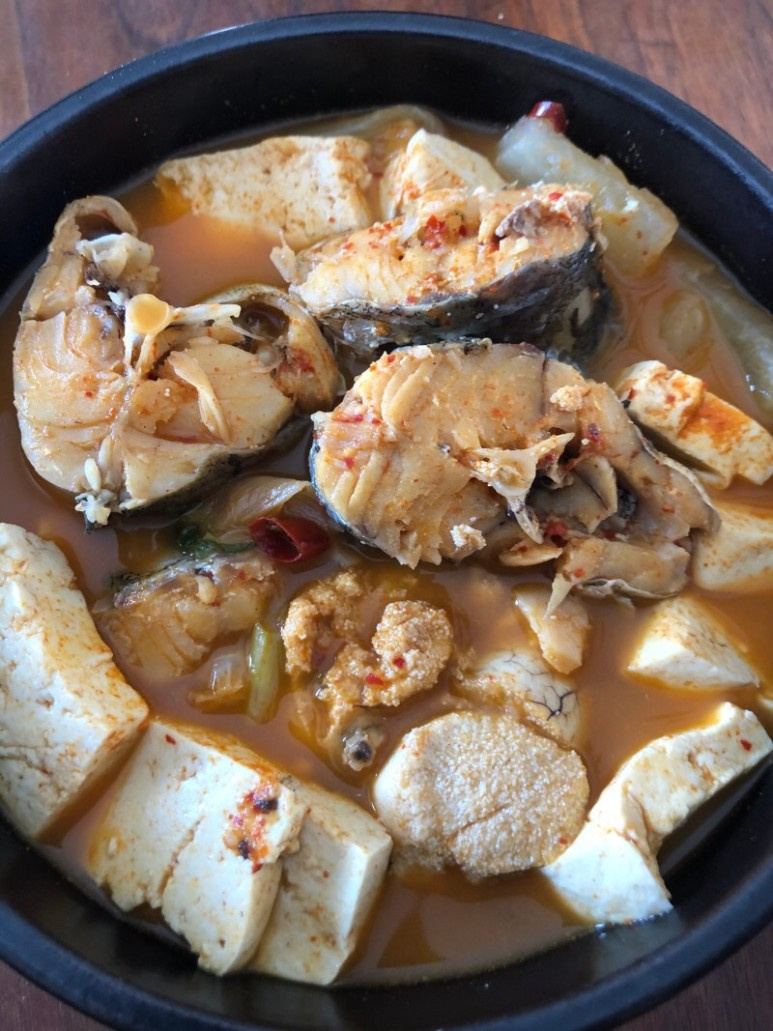Spicy Pollock Stew (Dongtae-tang) Recipe
How to Make Deliciously Spicy Pollock Stew (Dongtae-tang): A Step-by-Step Guide from Preparation to Serving

Craving a warming and invigorating bowl of Dongtae-tang on a chilly day? Pollock is packed with essential amino acids like methionine and niacin, which aid in liver detoxification, and is rich in Omega-3 fatty acids, known for preventing atherosclerosis and heart attacks. This recipe, inspired by the popular Korean cooking show ‘Sumine Banchan’, guides you through every step, from properly cleaning the pollock to creating a perfectly balanced, spicy broth. Enjoy a hearty and flavorful stew that’s perfect for cold weather!
Main Ingredients- 2 pollock (dongtae), fresh
- 1/4 large Korean radish (mu)
- 1400ml anchovy broth (about 7 paper cups)
- 1/2 onion
- 1 stalk green onion
Spicy Seasoning Ingredients- 1 Tbsp doenjang (fermented soybean paste)
- 1 Tbsp minced ginger or ginger powder
- 1 Tbsp minced garlic
- 2 and 1/2 Tbsp soy sauce (ganjang)
- Pinch of salt (or salted shrimp, saeu-jeot, to taste)
- 1 Tbsp plum extract (maesil-cheong)
- A little dried or fresh chili peppers (for extra spice)
- 1 Tbsp doenjang (fermented soybean paste)
- 1 Tbsp minced ginger or ginger powder
- 1 Tbsp minced garlic
- 2 and 1/2 Tbsp soy sauce (ganjang)
- Pinch of salt (or salted shrimp, saeu-jeot, to taste)
- 1 Tbsp plum extract (maesil-cheong)
- A little dried or fresh chili peppers (for extra spice)
Cooking Instructions
Step 1
First, peel the quarter of the large Korean radish and slice it into thick, bite-sized pieces (nabak-썰기). Add the radish to a pot with 1400ml of anchovy broth (approximately 7 paper cups) and bring it to a boil until the radish is slightly tender. Boiling the radish first will give the broth a clean and refreshing taste.

Step 2
Once the broth starts boiling, carefully add the 2 cleaned pollock pieces into the pot. Let it simmer over medium heat.

Step 3
As the broth returns to a boil, it’s time to add the flavorings! Stir in 2 Tbsp gochugaru (Korean chili flakes), 1 Tbsp doenjang, 1 Tbsp minced ginger (this is key to removing any fishy smell!), 1 Tbsp minced garlic, and 2 and 1/2 Tbsp ganjang (soy sauce). Mix everything well. This combination of seasonings will eliminate any fishy odor from the pollock and create a rich, spicy flavor.

Step 4
Chop the half onion into thick slices and slice the green onion stalk diagonally. Cutting them thick ensures they hold their shape and texture while cooking in the stew.

Step 5
Once the seasonings have blended well, add the prepared onion and green onion to the pollock stew and let it simmer for a bit longer. The vegetables will soften and release their natural sweetness into the broth.

Step 6
Now it’s time to season the stew to perfection. Taste the broth and add salt (or a pinch of salted shrimp, saeu-jeot, for an extra umami boost) until it reaches your desired level of saltiness.

Step 7
Finally, add one block of soft tofu, cut into generous pieces. The tofu will absorb the delicious broth and make the stew even more satisfying.

Step 8
Next, add 1 Tbsp of plum extract (maesil-cheong). This helps to further neutralize any remaining fishiness and adds a subtle sweetness and depth of flavor.

Step 9
After adding the tofu and plum extract and simmering for a moment, turn off the heat. If you have crown daisy (ssukgat) or water dropwort (minari), add them just before turning off the heat for a fresh, aromatic finish.

Step 10
Ladle the hot pollock stew into individual bowls, making sure to include plenty of broth. It’s a visually appealing and inviting dish.

Step 11
Your delicious Dongtae-tang is ready! The combination of the spicy, refreshing broth, tender pollock, savory roe, and soft tofu creates an exceptional taste that will make you want to devour a bowl of rice with it.

Step 12
The pollock meat, rich and plump, slides easily off the bones. Each bite of the firm yet tender pollock is a delightful experience. This wonderful texture and flavor are truly what makes Dongtae-tang so captivating!

Step 13
[How to Prepare Pollock] Start by trimming off the fins from the pollock. Be careful as they can be sharp. 
Step 14
Use a knife or a scaler to thoroughly scrape off all the scales from the pollock’s skin. Removing the scales ensures a cleaner taste and texture.

Step 15
Cut off the pollock’s snout.

Step 16
Carefully remove the gills. It’s important to clean this area thoroughly to remove any remaining blood or impurities that could cause an off-flavor.

Step 17
Make an incision along the belly of the pollock and gently remove the internal organs, including the roe. If the roe is intact and clean, rinse it well and set it aside for use. (Discard the organs as they can impart a bitter taste).

Step 18
Thoroughly clean and remove any blood clots or debris clinging to the backbone. This step is crucial for preventing any fishy smell in your stew.

Step 19
Inside the pollock’s body cavity, there’s a thin membrane or lining. Scrape this away completely as it can also contribute to a fishy taste.

Step 20
After all the cleaning is done, rinse the pollock under cold running water and then drain it thoroughly in a colander. Your pollock is now ready for cooking!



